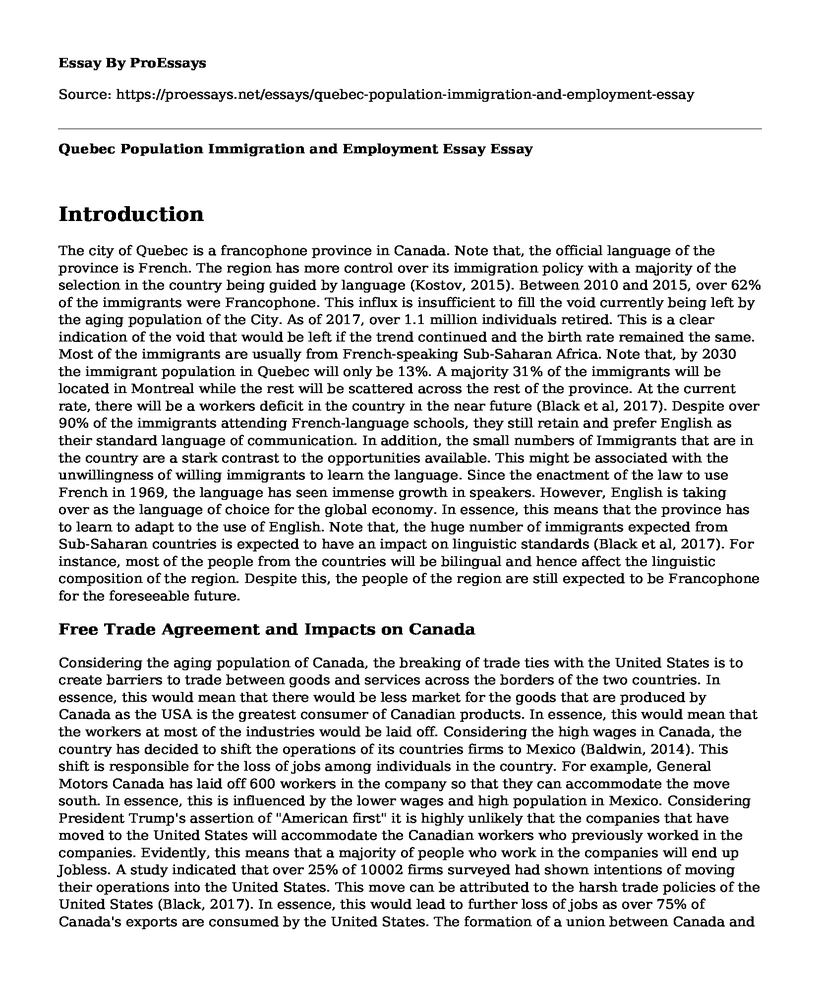Introduction
The city of Quebec is a francophone province in Canada. Note that, the official language of the province is French. The region has more control over its immigration policy with a majority of the selection in the country being guided by language (Kostov, 2015). Between 2010 and 2015, over 62% of the immigrants were Francophone. This influx is insufficient to fill the void currently being left by the aging population of the City. As of 2017, over 1.1 million individuals retired. This is a clear indication of the void that would be left if the trend continued and the birth rate remained the same. Most of the immigrants are usually from French-speaking Sub-Saharan Africa. Note that, by 2030 the immigrant population in Quebec will only be 13%. A majority 31% of the immigrants will be located in Montreal while the rest will be scattered across the rest of the province. At the current rate, there will be a workers deficit in the country in the near future (Black et al, 2017). Despite over 90% of the immigrants attending French-language schools, they still retain and prefer English as their standard language of communication. In addition, the small numbers of Immigrants that are in the country are a stark contrast to the opportunities available. This might be associated with the unwillingness of willing immigrants to learn the language. Since the enactment of the law to use French in 1969, the language has seen immense growth in speakers. However, English is taking over as the language of choice for the global economy. In essence, this means that the province has to learn to adapt to the use of English. Note that, the huge number of immigrants expected from Sub-Saharan countries is expected to have an impact on linguistic standards (Black et al, 2017). For instance, most of the people from the countries will be bilingual and hence affect the linguistic composition of the region. Despite this, the people of the region are still expected to be Francophone for the foreseeable future.
Free Trade Agreement and Impacts on Canada
Considering the aging population of Canada, the breaking of trade ties with the United States is to create barriers to trade between goods and services across the borders of the two countries. In essence, this would mean that there would be less market for the goods that are produced by Canada as the USA is the greatest consumer of Canadian products. In essence, this would mean that the workers at most of the industries would be laid off. Considering the high wages in Canada, the country has decided to shift the operations of its countries firms to Mexico (Baldwin, 2014). This shift is responsible for the loss of jobs among individuals in the country. For example, General Motors Canada has laid off 600 workers in the company so that they can accommodate the move south. In essence, this is influenced by the lower wages and high population in Mexico. Considering President Trump's assertion of "American first" it is highly unlikely that the companies that have moved to the United States will accommodate the Canadian workers who previously worked in the companies. Evidently, this means that a majority of people who work in the companies will end up Jobless. A study indicated that over 25% of 10002 firms surveyed had shown intentions of moving their operations into the United States. This move can be attributed to the harsh trade policies of the United States (Black, 2017). In essence, this would lead to further loss of jobs as over 75% of Canada's exports are consumed by the United States. The formation of a union between Canada and Europe is expected to create a market for the multiple exports that the United States is expected to stop importing. in the long run, this would save jobs for the Canadian workers in the company and create room for the immigrant population to also get employed.
References
Baldwin, J. R., & Gu, W. (2014). Trade liberalization: Export-market participation, productivity growth, and innovation. Oxford Review of Economic Policy, 20(3), 372-392.
Black, J., & Hagen, D. (2017). Quebec Immigration Politics and Policy: Historical and Contemporary Perspectives. Quebec: State and Society, 2nd ed., Toronto, Nelson Canada.
Kostov, C. (2008). Canada-Quebec immigration agreements (1971-1991) and their impact on federalism. American Review of Canadian Studies, 38(1), 91-103.
Cite this page
Quebec Population Immigration and Employment Essay. (2022, May 17). Retrieved from https://proessays.net/essays/quebec-population-immigration-and-employment-essay
If you are the original author of this essay and no longer wish to have it published on the ProEssays website, please click below to request its removal:
- A Discussion on Childhood Obesity Essay
- Globalization in Hospitality Industry Essay
- The Relationship of Trauma to Mental Disorders Among Trafficked and Sexually Exploited Girls and Women
- Stereotyping: Reducing Social Participation & Creating Distance - Essay Sample
- The Ku Klux Klan: An Overview of Its History and Impact - Essay Sample
- Exploring Intersectionality: How it Empowers the Disabled - Essay Sample
- Paper on Culture, Ethnicity, and Judith Butler: A Reflection







